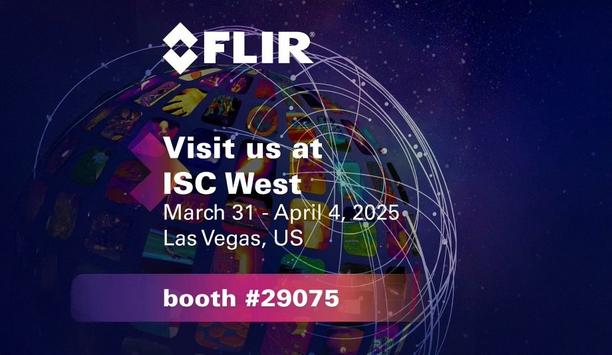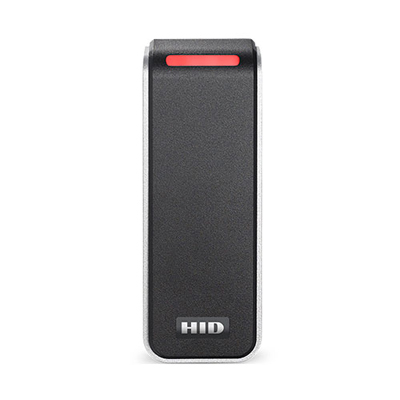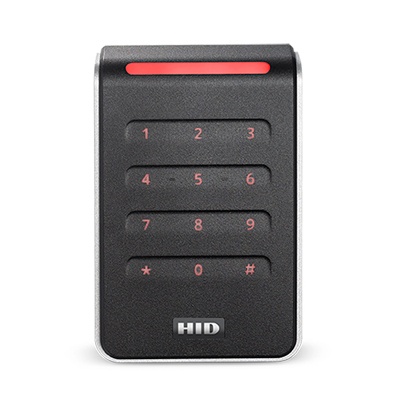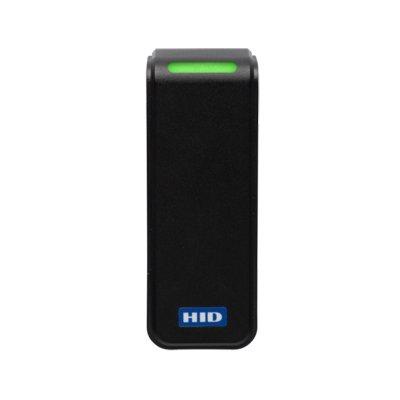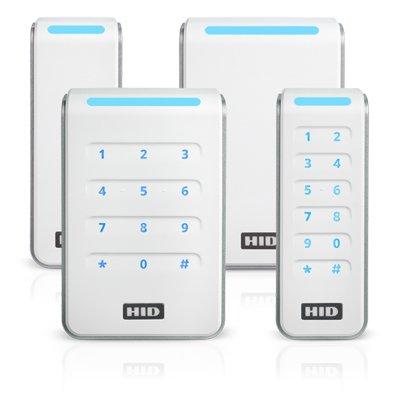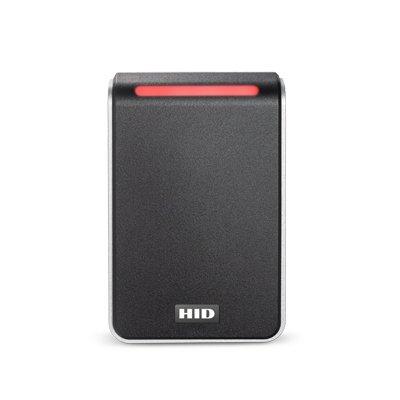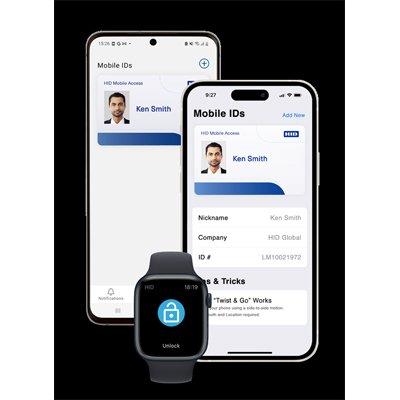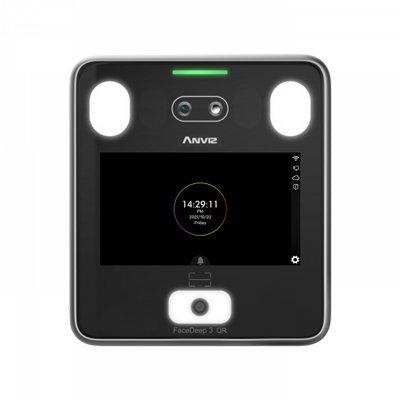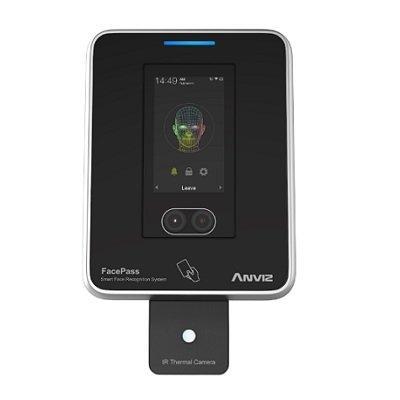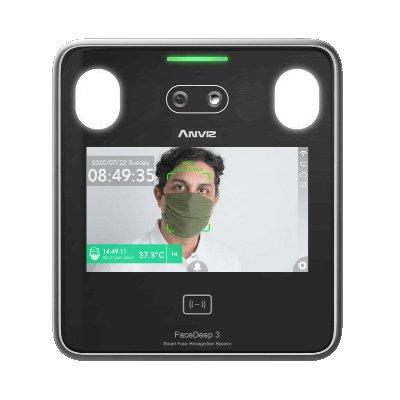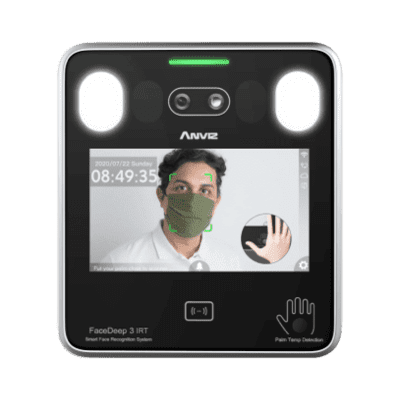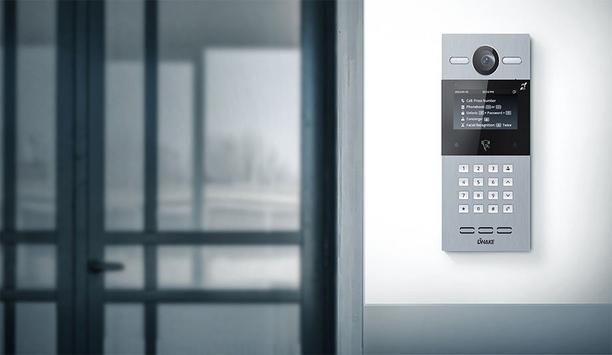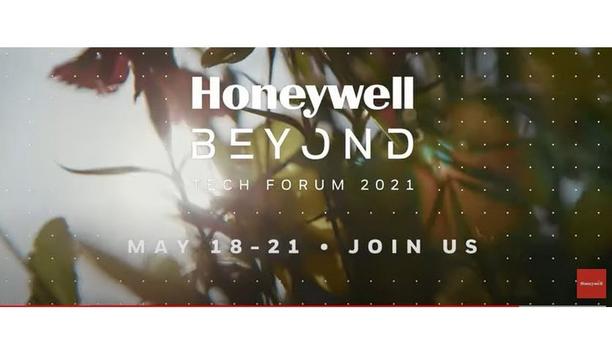Touchless Security
Anviz, a pioneer in intelligent security solutions, proudly announces the launch of W2 Face, its latest hybrid biometric access control and attendance terminal. Designed to meet the evolving needs of modern enterprises, the W2 Face combines facial recognition, fingerprint authentication, and RFID capabilities in a compact, intelligent device built for dynamic workplaces. Responding to market evolution As the access control landscape shifts toward integrated multi-biometric solutions, business...
The 8th edition of Inter Airport Southeast Asia (IASEA) was held in Singapore from 25-27 March 2025. Spanning across 6,259 sqm of exhibition space, the airport exhibition and conference brought together 3,621 industry trade professionals from 53 countries and regions, and featured 134 exhibiting companies, including pavilions representing Germany, Italy, Japan, and Singapore. The event saw a 43% increase in exhibitor size and a 15.6% rise in attendee numbers, underscoring the rising significanc...
As the world emerges from the pandemic's shadow five years after it spread globally, everything seems to be back on track. Air travel volumes have matched and even surpassed the pre-COVID level. But are they truly “back”? The pandemic did more than just bring masks and border closures. It fundamentally reshaped the world, accelerating digitalisation beyond recognition and irrevocably redefining security paradigms and human behaviour. Heightened security concerns Standard solutions...
HID, a pioneer in trusted identity solutions, introduces the HID Amico™ biometric facial recognition readers—designed to address the growing demand for secure, seamless and contactless access. This preview highlights the dependable choice for businesses prioritising convenience and security, with availability expected later in 2025. Advanced levels of security HID Amico provides advanced levels of security, reducing unauthorised access risks Leveraging industry-leading, NIS...
Managing visitor access efficiently has become a critical component of business operations across industries. With increasing security concerns, regulatory compliance, and the need for seamless visitor experiences, organisations must adopt robust visitor management solutions. Traditional methods such as logbooks and manual tracking are no longer sufficient to meet the security and operational demands of 2025. Digital solutions Modern businesses require digital solutions that not only enhance...
Honeywell Building Automation is heading to ISC West 2025, taking place March 31-April 4 at the Venetian Expo in Las Vegas, and this year promises to be a true milestone. For the first time, Honeywell is bringing together two of its powerhouse brands—LenelS2 and Honeywell Commercial Security—in a unified presence. Honeywell's latest offerings Honeywell is displaying a wide variety of the latest offerings that blend LenelS2’s access control Honeywell will be stationed a...
News
HID, a pioneer in trusted identity and access control solutions, debuts its latest innovations at ISC West 2025. As the industry accelerates its shift toward mobile-first and seamless security integrations, HID has been working on solutions to create smoother and more secure access across touchpoints—from entryways to internal systems—optimising workflows and minimising disruptions. Integrated security ecosystems “HID is at the forefront of driving a world of seamless security, combining our deep expertise with continuous innovation to meet the evolving needs of modern access control and identification,” said Ramesh Songukrishnasamy, senior vice president and chief technology officer at HID. “As organisations embrace mobile-first solutions and integrated security ecosystems, HID remains committed to delivering cutting-edge technologies that streamline access, enhance user experiences, and reinforce security and secure identity at every touchpoint.” Future of secure identity and access control Visit HID at booth #8053 and Mercury™ at booth #27109, where attendees will have the opportunity to experience this shift firsthand, and see the future of secure identity and access control in action: HID Signo™ Readers: Versatile, Secure, and Future-Ready Reader, a multi-factor authentication key meeting FIPS-201 compliance and NIST 800-116 guidelines The flagship HID Signo Readers offer unparalleled versatility, supporting a broad range of credential technologies—including cards, fobs, digital wallets, and government-issued credentials like PIV, CAC, and TWIC. Designed for modern workplaces and high-security environments, the portfolio now includes the new HID Signo PIV Contact Reader, a multi-factor authentication solution meeting FIPS-201 compliance and NIST 800-116 guidelines. When integrated with Mercury MP4502 controllers, it delivers high-assurance security for U.S. Federal Government entities and organisations managing single facilities or global networks. New! Mercury Embedded Application Environment: Scalable, Interoperable, and Empowering The Mercury embedded application environment is an open platform that enables OEMs and technology partners to develop and deploy custom applications directly on Mercury MP Controllers. Unlike traditional access controllers that rely on server-based logic and are limited in upstream system connections, this platform brings real-time logic processing to the edge, reducing latency, increasing availability and enhancing system redundancy. New! HID Integration Service: Streamlined Connectivity and Enhanced Interoperability This integration platform-as-a-service (IPaaS) was designed to empower application developers, solution integrators, and software vendors to seamlessly and rapidly integrate essential physical security solutions, solving the industry-wide struggle with managing third-party integrations. New! OMNIKEY SE Plug Reader OMNIKEY SE Plug supports passkeys and other MFA methods for enhanced security Revolutionise logical access with a cable-free reader that provides secure, passwordless authentication for mobile professionals. Ideal for hybrid workplaces (like healthcare, retail, law enforcement and other enterprise environments), it ensures your workforce has seamless access to corporate resources from any location – whether in the field, while working remote or when travelling. This versatile reader offers multi-device compatibility — working effortlessly with smartphones, tablets and laptops using a USB-C interface. OMNIKEY SE Plug supports passkeys and other multi-factor authentication (MFA) methods for enhanced security against phishing and credential theft. HID Mobile Access: The Future of Secure, Contactless Authentication HID Mobile Access solutions leverage smartphones and wearables for secure, convenient and touchless authentication, making them ideal for any environment where access control is needed, including workplaces, universities, commercial real estate, financial institutions and more. Streamline management with the HID Origo™ portal, centralising user management and integrating seamlessly with access control systems. Reduce the need for physical encoding, printing, and returns, and embrace a future where access control is simple and efficient. HID Linq™: Smart Device Management and Real-Time Insights HID Linq tool provides real-time device state reporting and remote configuration HID will demonstrate the powerful HID Linq tool platform, designed for seamless device management through Mercury controllers and HID Signo readers. The HID Linq tool provides real-time device state reporting, remote configuration and adjustments capability, as well as seamless firmware updates. HID FARGO HPD5000e printer: High-quality, Personalised Retransfer Technology Making its ISC West debut, the printer was engineered for universities, medium-to-large businesses, healthcare facilities and government agencies who need retransfer printing technology to effectively personalise contactless cards and for any organisation looking to switch from a higher-end, direct-to-card printer to a retransfer printing solution for improved image quality. HID four speaking sessions Additionally, HID will showcase its industry leadership through participation in four speaking sessions, highlighting the expertise of its thought pioneers: The Impact of Identity on the Physical and Digital Access Landscape – April 1, 10 a.m. PST Security Women Actively Supporting Women – How to Develop and Enhance Employee Resource Groups Focused on Women – April 2, 2:15 p.m. PST Retrospective/Future: What Does the Security Experience for Today’s Younger Generation Mean for the Future? April 2, 11:15 a.m. PST Optimising the Future of Workplace Experience – April 1, 1 p.m. PST
Iris ID, the global pioneer in iris recognition technology, will be demonstrating their latest breakthrough contactless biometric identity authentication solutions at ISC West 2025 in booth #28057. Visitors will have the opportunity to experience the company's latest identity portfolio of products, including the advanced IrisAccess® iA1000 and IrisTime® iT100 designed for easy integration into security and time management ecosystems. Time management ecosystems "As security threats grow in frequency and sophistication, organisations need the unparalleled identity authentication accuracy that only iris + face fusion biometrics deliver," said Mohammed Murad, Vice President of Iris ID. "Our iris fusion solutions combine the latest advancements in iris+face technologies, user convenience, and reliability to elevate security, and time and attendance applications.” The iA1000 supports biometric capture from distances between 30 to 60 cm The recently-released IrisAccess® iA1000 is a multi-modal iris and facial recognition device employing Iris-Face Fusion technology for fast, contact-free authentication. Key features include dual iris and face recognition cameras, a circular LCD screen for intuitive user guidance, and robust security protocols such as AES 256-bit encryption and Presentation Attack Defense. Designed for use in a wide range of applications—from access control to public security—the iA1000 supports biometric capture from distances between 30 to 60 cm (12-32 inches). Automatic tilt adjustment The IrisTime® iT100 Iris and Face Recognition System is a non-contact biometric time and attendance solution integrating iris and facial recognition. With simultaneous capture of iris and face biometric data, the iT100 provides flexible authentication modes for a wide range of deployment environments. Features include automatic tilt adjustment, and a 7-inch multi-touch display that simplifies on-device enrolment, and an open Android platform to support third-party application development.
Quorum Cyber, a proactive, threat-led cybersecurity company, has been awarded the Identity and Access Management Specialization from Microsoft. As a Microsoft Solutions Partner for Security, the company now holds all four available Microsoft Security specializations: Threat Protection, Cloud Security, Information Protection and Governance, and Identity and Access Management. Exclusive security specialisation Quorum Cyber in an exclusive group of Microsoft partners who hold all four security specializationsThis achievement places Quorum Cyber in an exclusive group of Microsoft partners who hold all four security specializations – less than half a percent of partners globally have achieved this distinction. This new specialization allows the company to showcase its proven, verifiable expertise in deploying Microsoft Identity workloads. It helps customers identify partners with the technical capabilities and proven experience deploying Microsoft Identity workloads using Microsoft Entra ID, a cloud-based identity and access management service. Certified cybersecurity Quorum Cyber’s expertise was verified through customer references and Microsoft exams to ensure it can deploy and manage workloads, including managing and securing identities, implementing identity governance, and deploying conditional access policies using Microsoft technologies such as Microsoft Entra ID. Microsoft security partners Quorum Cyber was founded as a Microsoft-only security services provider and member of the MISAWith a close and longstanding relationship with Microsoft, Quorum Cyber was founded as a Microsoft-only security services provider and member of the Microsoft Intelligent Security Association (MISA). In 2024, it was a Microsoft Partner of the Year finalist for demonstrating excellence in innovation and implementation of customer solutions based on Microsoft technology. At the Microsoft Security Excellence Awards in 2024, it was named a Security MSSP of the Year finalist and Security Customer Champion finalist. And Difenda, which Quorum Cyber acquired in 2024, was also shortlisted for Security MSSP of the Year. Strengthening identity security Quorum Cyber has a strong vision for identity security. It remains committed to investing in recruiting and training skilled team members, as well as obtaining industry-recognized certifications, to protect its customers in an inhospitable and unpredictable digital landscape. Advancing security excellence "Gaining the Identity and Access Management specialization from Microsoft underscores our steadfast commitment to securing our customers' identities and data," said Federico Charosky, Chief Executive Officer of Quorum Cyber. "This recognition showcases our proficiency in identity security and reaffirms our dedication to upholding the highest standards. We are extremely proud to have obtained all four Microsoft Security specialisations and look forward to helping our customers benefit from the additional opportunities this achievement brings."
FLIR, an industry pioneer in visible and thermal imaging sensors for security applications, will use ICS West 2025 to show visitors how they can benefit from adopting a multi-layered approach to their security challenges. With extensive experience across applications that include fence line/perimeter protection, parking lots, outdoor area protection, and entry/interior area protection, FLIR designs its solutions as building blocks that can integrate to form a robust multi-layered security solution. Advancing security strategies ISC West 2025 is a comprehensive security trade event taking place from March 31 to April 4 ISC West 2025 is a comprehensive and converged security trade event taking place from March 31 to April 4 at the Venetian Expo convention center in Las Vegas, USA. On Stand 29075, FLIR will emphasise that today’s security response has to be precise, quick, flexible, and robust in the face of threats that are more intelligent and complex than ever before. Real-time threat detection Ensuring the safety and protection of people and the security of buildings is becoming ever more challenging, rendering traditional security models insufficient. The way forward lies in developing advanced situational awareness capabilities, namely a security framework that not only reacts to threats but also supports active prevention. Detecting threats in real time, responding with precision, and continuously adapting to emerging risks is crucial for upholding safety and security. Multi-layered security solutions FLIR cameras seamlessly integrate with third-party VMS complying with the US NDAA At ICS West 2025, FLIR will demonstrate how, using the latest multi-layered security solutions, turns this idea from concept into reality, creating several barriers for potential intruders. A combination of technologies strengthens each stage of the security journey from initial detection to identification and tracking, stopping threats before they cause harm. Smart perimeter protection By combining thermal, visible, and ground-based radar imaging with FLIR’s pioneering Virtual Barrier video analytics, multi-layered solutions provide the strategic building blocks to detect, identify, track, and act over a long range and in any weather conditions. Central to any multi-layered solution is thermal imaging technology. FLIR cameras integrate with third-party video management systems (VMS), adhere to strict cybersecurity protocols, and comply with the US National Defense Authorization Act (NDAA). FLIR’s camera innovations At ICS West, the FLIR stand will host a number of key camera innovations At ICS West, the FLIR stand will host a number of key camera innovations, including the FC-AI-R rugged thermal radiometric camera. The FLIR FC-Series AI-R integrates deep neural network and motion analytics. With a thermal sensitivity of <35 mK NETD, this advanced radiometric camera offers enhanced situational awareness and clear image quality for perimeter security and physical asset safety. AI-Powered thermal surveillance Also in the spotlight will be the FLIR Quasar PTZ AI PTZ (pan-tilt-zoom) infrared thermal camera. Featuring edge AI video analytics to detect and accurately classify humans and vehicles, applications include commercial and critical infrastructure sites, remote facilities, or any large area requiring close monitoring. Elsewhere on the FLIR stand will be the FH-R-PTZ, a multi-spectral pan-tilt-zoom radiometric camera. Upon detecting a hot spot or surface temperature change, the contactless temperature measurement is sent to the operator through a connected VMS for instantaneous assessment and deployment of response tactics. Expert security insights at ICS West Visitors to ICS West 2025 seeking a technical discussion about multi-layered security or any other solutions can tap into the expertise of FLIR professionals, with representatives from both engineering and sales available on the stand. A Spanish speaking representative will also be present.
With new life-saving drugs being created every day, the pharmaceutical industry is directly involved in saving human lives across the world. With how important the work of this sector is, it becomes more important to leverage physical access control for the pharmaceutical sector. This helps to protect intellectual property and physical as well as human assets. Top concerns about security The top concerns about security in pharmaceutical industries include the safety of materials The top concerns about security in pharmaceutical industries include the safety of materials in the company warehouse and the security of confidential information. These losses can lead to issues inclusive of drug counterfeiting, brand damage, and many more that affect the company as a whole. Access control and pharmaceutical companies With risks that it faces internally as well as externally, these companies need to strengthen their less secure areas. Healthcare data, research details, company secrets, manufactured end-products – there is a requirement for special access provisions to control the flow from places containing these important elements. There are rapid changes happening in security needs, especially physical access control for pharmaceutical companies and the changing nature of security breaches. Inefficient access control solutions There is another dimension to access control systems for these companies beyond security reasons The major pain to solve here is to remove inefficient access control solutions for the pharmaceutical sector. Fighting a war with badly equipped weaponry leads to sure defeats. This brings us to the conclusion that a well-built access control system is the need of the hour for pharmaceutical companies to fight security issues. But, there is another dimension to access control systems for these companies beyond security reasons. The need for access control beyond security The answer to that thought is a big YES! While elements pertaining to security are to be controlled, it is equally important for pharma companies to maintain the environment within their production units, research divisions, and packaging units. All through the processes involved in these units, there is a high requirement for the environmental conditions to be controlled as per the need. This is because environmental factors such as humidity, temperature, allowable particle size, and more have a degrading effect on product quality, shelf-life, and more such properties. This affects the quality of the drug or the raw materials needed to make the drug. How access control solutions solve this trouble Different solutions provide different answers to this key problem within the pharmaceutical industry Beyond these concerns, sanitation and hygiene are equally important aspects needed for the smooth functioning of such facilities. While devices can help maintain the environment within the facilities, there are high chances of contamination occurring at the entry and exit points. If not checked, this can further lead to the spread of contamination across the facilities and hence needs to be curbed right away. This is where the Access Control Solution comes into the picture. Different solutions provide different answers to this key problem within the pharmaceutical industry. Let them understand how access control solutions solve this trouble. Leveraging access control for controlled traffic The only way to control traffic is to control the door that allows entry or exit from that area. For all access, the opening of the door is to be set in such a way that it opens only on certain conditions. Failure to match these conditions will cause the door to stay closed and in turn, protect it from any harmful elements, especially in environmentally sensitive areas. Full Control over the door can be achieved using a dedicated door interlock in conjunction with door sense or similar devices. It can also be achieved using a normal access door controller with advanced access features. The method of ensuring control over a particular space with two doors in tandem is called Door Interlocking. It goes by many other names such as Airlock, Mantrap, or Tiger Trap. Basic functioning The framework is created to not allow the opening of one door if the other door is open The Door Interlocking establishes a closed environment by controlling two or more doors that enclose a singular space. As a part of access control, it incorporates a trapped environment for anyone before they enter or exit a secure space, especially a space with high demands of environmental conditions. In the simplest form, similar to an airlock, this framework for door interlocking is made of two doors connected through electronic means. The framework is created to not allow the opening of one door if the other door is open. Introduction of contactless credentials The benefits also become more apparent with the introduction of contactless credentials. Beyond conventional biometric access control, Contactless credentials such as Face Recognition and Mobile Credentials bring in a higher amount of hygiene control. With such features, the Man trap feature brings in true contactless access within the environment-controlled units. Benefits of door interlocking Functionally, door interlocking helps maintain certain environmental standards for their exclusive unit needs. This is true, especially in manufacturing and R&D units. The benefits that accompany this feature are listed below: Reduction in contamination despite high-volume traffic Reduction in overall Manpower and maintenance cost Reduction in overall contamination including those of micro-biological and particulate nature Prevention of unauthorised as well as multiple entries Wrapping up Matrix Access Control Solution for Pharmaceutical Companies brings greater control over security within their facilities. Especially with its advanced access features, they can leverage the same access architecture. This helps to control entry and exit points throughout the important units requiring delicate environment control without additional devices. With decades of experience in the world market, Matrix leverages its active insight into the security needs of the organisation.
Themed “Airport Operations for Tomorrow”, inter airport Southeast Asia 2025 (IASEA) curated a lineup of conference sessions and the latest innovations to drive conversations on what a sustainable tomorrow looks like for Asia’s airport operations and ground handling industry. From 25-27 March 2025, the 8th edition of IASEA is expected to gather over 4,000 attendees, 150 notable global brands and some 50 industry experts as speakers at the iconic Marina Bay Sands, Singapore. IASEA 2025 Conference–Mastermind keynotes The session will discuss keys that improve operational efficiencies and lay the foundation for resilient Setting the stage for this conference on day 1 (25 March) is the fireside chat titled Reshaping Global Airport Operations by Patrick Ky, CEO, International Centre for Aviation Innovation (ICAI), an industry pioneer with nearly three decades worth of aviation experience. Moderated by Glory Wee, Senior Director, Aviation Development Group, Civil Aviation Authority Singapore (CAAS), the session will discuss solutions that improve operational efficiencies and lay the foundation for resilient and future-proof airports. Next-generation air navigation services “Globally, Asia Pacific takes the lead as the region with 60% of the total number of airport projects, and the region’s carriers handled 31 million international passengers, which was a 19.8% increase in November 2024 compared to November 2023. Recognising the need to address ground and airspace capacity constraints and manpower shortages, while keeping up with increasing passenger footfall in the region, the International Centre for Aviation Innovation was established in Singapore,” said Patrick Ky, CEO, International Centre for Aviation Innovation (ICAI). “ICAI focuses on research and development projects for next-generation air navigation services, automated and smart airports, and unmanned aviation systems and sustainable aviation. At the upcoming IASEA 2025, I’m excited to share insights into new innovations that will be tested in Singapore before being deployed globally.” Skytrax’s World Top Airport List 2024 Keynote sessions led by two of the top 5 airports according to Skytrax’s World Top Airport List 2024 This will be followed by keynote sessions led by two of the top 5 airports according to Skytrax’s World Top Airport List 2024. The first keynote, Airports of The Next Decade & Beyond with Shinichiro Motomiya, General Manager, Narita International Airport Corporation, will provide insights into the master plan of Narita International Airport – a case study of the airport of the future, and Airport in Brief: Incheon Airport with Soonil Hwang, Deputy Director of Fast Travel Team, Incheon International Airport Corporation, will cover a deep dive into the airport’s Digital Transformation Project. New Narita Airport expansion project Shinichiro Motomiya, General Manager, Narita International Airport Corporation, shared, “To ensure that airports can keep up with this surging demand in air traffic today, it’s become paramount for the industry to accelerate conversations on what will make airports sustainable, improve operational resilience and passenger experience. Take the ‘New Narita Airport’ expansion project as a case in point, which we will share about during the keynote session." "The airport development project for the 2030s is looking at consolidating terminals and building a new cargo area to allow for the expected increase of passenger capacity from 57 to 75 million and cargo capacity from 2.4 to 3.5 million tons at Narita International Airport.” Use of Artificial Intelligence technologies Soonil Hwang, Deputy Director of the Fast Travel Team, Incheon International Airport Corporation commented, “We should not shun away from the use of Artificial Intelligence technologies, especially in the aviation industry. At Incheon International Airport, we believe that technology will strike a fine balance between passenger experience and operational efficiency." "Hence, we’ve analysed customer demands and drawn a Persona Journey Map to design solutions around it. As we complete Phase 4 of the transformation of Incheon International Airport, it is my pleasure to share at the upcoming IASEA how we’ve identified values such as ‘Convenient Journey’ or ‘Time’ and utilised them to elevate the customer experience.” Challenges in ground management Minh will cover the solutions needed to address challenges in ground management The morning of the opening day will also see Nguyen Dang Minh, Head of Airport Operations Department, Airports Corporation of Vietnam (ACV) spearhead the next keynote, Vietnam Airport Development Masterplan 2030. Vietnam stands as a pioneer in the aviation landscape, aiming to expand its airport network to 30 airports by 2030 and a long-term vision extending to 2050 that includes upgrades to increase annual passenger capacity by over 80%. As new airports are being built and existing ones upgraded, Minh will cover the solutions needed to address challenges in ground management, security, and resource allocation that will enable airport operations to evolve alongside Vietnam’s expanding aviation network. How transformative technology, greener practices Day 2 of the conference will open with the keynote Global Action Plan for the Prevention of Runway Incursion. With safety as a top priority for the aviation industry, and runway incursions as one of the top five high-risk categories of aviation risks, the session will be led by Mitch Fox, Director, Asia Pacific Centre for Aviation Safety, Flight Safety Foundation, who will cover recommendations from the Global Action Plan for the Prevention of Runway Incursions (GAPRI) that go beyond simple regulatory compliance. Aside from safety, efficiency and sustainability are the next priorities to drive airports of tomorrow. Brad Moore, CEO, APAC, Swissport International AG, will lead the next keynote Redefining Ground Support Excellence in Asia Pacific to examine how transformative technology, greener practices, and strategic innovation are unlocking new opportunities for ground handling – a critical backbone of the aviation system. Aside from these mastermind keynotes, other industry experts and thought pioneers from the airport industry will join the conference, sharing their groundbreaking strategies for transforming terminal and ramp operations to address the challenges of today's demanding and rapidly changing aviation landscape. Some of the conference highlights Using Data Analytics to Optimise Airport Operations Rethinking Passenger Flow: Unravelling the Knot of Terminal Congestion Transforming Baggage Handling: Best Practices for Modern Airports Future-Proofing Airport Security: Balancing Safety, Technology & Passenger Experience Boosting Operational Resilience: Preparing for the Unexpected State-of-the-art solutions at inter airport Southeast Asia 2025 As the reference point for the future of airports, IASEA 2025 will stand as a platform to unveil the latest aviation technologies aimed at streamlining workflows, improving sustainability and elevating operational capabilities. Automation will continue to play a pivotal role in ever-growing passenger expectations. SITA’s 2024 Baggage IT Insights reveal that 80% of airports and 66% of airlines have put touchless self-service baggage handling in place, and more investments will continue in 2025. Award-winning airport management software Aligned with this change, industry expert Smith Detection will introduce to the Asia market the SDX 10060 XDi Aligned with this transformation, industry expert Smith Detection will introduce to the Asia market the SDX 10060 XDi, a ground-breaking X-ray scanner, offering highly accurate material discrimination and substance identification based on an object’s molecular structure. Separately, biometrics and digital identity pioneer NEC will showcase its facial recognition technology, ranked the world’s most accurate in a benchmark test conducted by the U.S. National Institute of Standards and Technology in 2024. ADB Safegate Singapore, who recently clinched awards for Environmental Initiatives, Innovation, Safety, and Business Expansion at the Airport Technology Excellence Awards 2024, will present their award-winning airport management software. Other notable brands to expect on the exhibition floor Aviaco GSE, CIAS, Colibri Energy, Cobus Industries, Datalogic, ewo, FAAC, Fastcharge, FibreFENCE by Fibre Net Spa, FLEX Industries, GRP Iluminacion, Honeywell, ITW GSE, Japan Radio Co., LEONARDO, Mallaghan, Mototok, NEC, OCEM Airfield, Oshkosh AeroTech, Poltrona Frau, Roypow Technology GmbH, SICK AG, ShinMaywa, Thales, TCR, TLD Asia, Toyota Industries Corporation, TREPEL and Weihai Guangtai. All registered professionals for inter airport Southeast Asia 2025 will be granted free access to the exhibition and conference floors. For the latest information on inter airport Southeast Asia, please visit the event website, LinkedIn, or Facebook pages.


Expert commentary
Access control solutions will continue their evolution in 2025 as organisations assess and adapt to dynamic and increasingly dangerous threats. Trends to watch include the growing adoption of mobile access credentials and digital IDs, and the integration of digital and physical security and other technologies. Other ongoing trends include the integration of AI into access control solutions and the increasing adoption of contactless biometrics for enhanced convenience. New access control innovations As these trends gather momentum, they highlight the pivotal role access control systems play in combining security and convenience, every hour of every day. Organisations must strike the ideal balance between a secure environment and satisfying user experience if they are to meet increasingly vocal demands for both. Achieving this balance not only delivers the expected user experience but also delivers multi-layered threat protection while introducing exciting new access control innovations. Digital technologies and open standards Modern access control solutions deliver a faster pace of innovation and dramatically improved capabilities Modern access control solutions deliver a faster pace of innovation and dramatically improved capabilities as compared to what was possible in the past. The primary objective is no longer simply to secure places and assets so they are beyond the reach of the wrong people. Now it also must be as easy as possible for authorised individuals to enter a building or access digital assets. Mobile access credentials and digital IDs are increasingly a preferred solution for achieving this seamless and convenient access experience. Technology convergence is happening at a rapid pace and this convergence makes it possible to integrate digital and physical security with real-time location systems and other technologies. Together, these converged technologies provide multi-layered protection against both cyber and physical threats while also enabling valuable new capabilities. 2024 State of Physical Access Control Report As AI is increasingly incorporated into access-control solutions, we will see even more powerful ways to leverage access control data for analytics use cases. Almost 40% of respondents to our 2024 State of Physical Access Control Report said they were looking to do this. Equally consequential is the rise of fast, frictionless and easy contactless biometrics solutions in a wide range of applications including healthcare, where 32% of respondents to our recent 2024 State of Healthcare Security Report said their facilities have already implemented this technology for authentication. Looking at the broader marketplace, nearly one in four (23%) respondents to our 2024 State of Physical Access Control Report cited biometrics when asked to “name the top three trends shaping the wider access control industry in the near future.” Evolution of access control solutions As access control solutions become increasingly central to secure and convenient daily life, these and other trends will have an ongoing impact on all market sectors from healthcare and banking to the corporate real estate enterprise and business and college campuses. At the same time, those responsible for a facility’s digital and physical assets know that these trends – and security in general – will never be a static proposition. The only constant is change. Threats will never stop evolving, and those tasked with protecting organisations against these threats must never stand still. The evolution of access control solutions that we saw during 2024 will continue through 2025 and beyond, and organisations will need to remain thorough and vigilant as they address today’s ever-expanding attack surfaces and ever-evolving attack schemes.
If you were to ask people outside our industry what door and access security entails, chances are their answers would reflect their common encounters with locks, security guards, cameras, and maybe metal detectors, badges, or automatic doors. But if they were curious enough, they’d probably be astounded to learn how extensive, intricate, and interesting the business can be and, of course, how vital it is to life safety, physical security, and cybersecurity. Integrated, interoperable solutions They’d also discover that it’s not just about levers, deadbolts, and other products. Instead, it’s a system of many systems, integrated, interoperable security solutions that cover everything from access control, video surveillance, fire alarms, and communications to server rooms, IT networks, energy efficiency, and more. Partnerships to keep up with changing needs A manufacturer’s support of their customers is how prepared they are to respond with high-quality advice Integral to the future success of the openings solutions industry is how well manufacturers and security experts keep up with the changing threat landscape and their customers’ evolving needs. Part of a manufacturer’s support of their customers is how prepared they are to respond with high-quality advice, service, and innovations that address the questions and concerns that arise. That’s why more developers, designers, and end-users alike are leaning on partnerships with visionary manufacturing companies and systems integrators who proactively keep their ear to the ground and an eye on the future. Caution: curves ahead As we look toward that future here in North America, there will always be forces of change to contend with and the accompanying impact on people’s safety, security, health, and livelihoods that our industry will need to address. The forces range from the incessantly unfolding threat scenarios in our country and the world’s geo-political dynamics to climate change and a host of other shifting factors, including the ways we want to work post-pandemic. Bypassing tailored approach Commoditisation poses risks to customised systems integration, good design, the environment Like many industries, ours has seen a change in the level of commoditisation in recent years. While this may give some customers access to cheaper door products in the short term, it usually means bypassing a tailored and more effective approach to security solutions that better meet risk assessment needs for the long haul. It can also get in the way of fulfilling a customer’s forward-thinking requirements for sustainable and aesthetic building materials. In other words, commoditisation, with its tendency toward “sameness” and dependency on less sustainable, corner-cutting materials and processes, poses risks to customised systems integration, good design, the environment, and potentially security itself. Change for the better Fortunately, change has its upside, especially as it applies to innovation, the counterforce to commoditisation. It’s the primary reason why progressive architects, integrators, and security professionals in North America keep gravitating to manufacturers with the instincts and resources to make bold investments in people, new ideas, and processes that produce advanced, planet-friendly solutions. From our view of the door security industry, sustainability will be a central component of innovation from here on out, where the development of new solutions and products is guided by practices and values that reduce their environmental footprint and increase their positive impact. Sustainably-made solutions Transparency in the form of documentation and third-party certifications to back up sustainability claims Along with being a top-down priority for certain manufacturers, sustainably made solutions and products are in higher demand than ever from the design, building, security, and end-user communities. They want to know about the carbon footprint and health impact of product ingredients, their recyclability, and how responsibly things are being made, packaged, and delivered. And they expect transparency in the form of documentation and third-party certifications to back up sustainability claims. Resilience Along with sustainability, a greater focus on resilience has emerged. Climate change is being looked at as a key contributor to the increase in wildfires and the intensity of windstorms and flooding. There will continue to be an expanding need moving forward for FEMA-rated storm shelters, fire- and water-resistive doors, and even blast-resistant openings for certain locations. On the near horizon Facial recognition has long been in use in government and other high-security applications The door security industry is also seeing a fusion of technologies, including newer touchless/contactless opening solutions that incorporate improved biometric access credentials like facial recognition. Facial recognition has long been in use in government and other high-security applications, and we’re starting to see more adoption and willingness to use advanced biometrics devices for door access. Video sensing data and analytics Fortunately, there are new strides regarding the transparency of the algorithms relating to facial recognition. Reassurances about the prevention of bias will help further that adoption. Voice and video will also soon become more prevalent for building and security management by using video sensing data and analytics to inform door security solutions. These developments often stem from the convergence of application engineering and systems integration. Application engineering It also advances the de-commoditisation of security and access control solutions Openings solutions innovators and manufacturers receive vital feedback and insight from both channel partners and customers about the characteristics of a vertical market and/or region. Not only does this partnership require trust and close working relationships, but it yields near and longer-term advantages to all participants. It also advances the de-commoditisation of security and access control solutions. Serving underserved communities Smaller businesses need to manage the security and safety of their personnel and assets just as larger operations do. The challenge has been how to offer the right fit of robust door security solutions that also fit these organisations’ budgets. Historically, they’ve been caught between having to choose an enterprise system that would provide the security they need but comes with a high price tag or settling for mechanical locking doors and a fire alarm system that will at least satisfy a certificate of occupancy requirement. Smart lock system Many small business owners want technology that’s simple to install, even DIY in some cases Many small business owners would like to add a smart lock system to enhance their company’s security which also gives them the flexibility to issue mobile credentials and manage employee and visitor access remotely. Ultimately, they’re looking for a higher level of functionality than what’s available at the low end but something with far less infrastructure and at a lower cost than what’s inherent with higher-end solutions. They also want technology that’s simple to install, even DIY in some cases. Scalable electronic access control Supporting these underserved customers requires developing scaled solutions to match the fewer doors, employees, and amount of space that smaller businesses need. This unique approach to electronic access control is new, but it’s already proving to be successful in helping organisations better manage their time, resources, and security. Training The need for expanded solutions awareness, product knowledge, and installation training is also growing The need for expanded solutions awareness, product knowledge, and installation training is also growing. Retirements and other changes within the locksmithing, systems integration, and facilities management sectors continue to affect how our industry needs to recruit, develop, and retain talent. So do technological advancements in electronic access control and door security hardware overall. Change, innovation, and learning A manufacturer or organisation that can offer comprehensive training led by seasoned professionals will go a long way toward expediting the onboarding of new hires and providing continuing education for experienced professionals at all levels and from all disciplines connected to safety and security. Ultimately, door security experts and companies who embrace change, innovation, and learning will gain the extra edge customers are always looking for to add value to their investments in security.
Amidst the challenges of a prevailing economic downturn, the retail sector finds itself grappling with an unparalleled rise in incidents of shoplifting, theft, and burglaries. The disconcerting scenes witnessed on London’s Oxford Street in August 2023, where crowds gathered, looting as many stores as possible, sent shockwaves across the nation’s retailers. This alarming surge in retail crime has put retailers on high alert, as they contend with a rising tide of security concerns. Shoplifting concerns Recent data from the Union of Shop Distributive and Allied Workers (USDAW), has raised alarming concerns: shoplifting rates have surged by an unprecedented 24%. In the first half of 2023 alone, there were approximately 8 million reported shoplifting incidents. With the ongoing burden of the cost of living crisis and the approaching festive season, it is expected that these figures will keep surging. Implementing robust security measures Theft and prevention strategies cost retailers approximately £2 billion in 2021/2022 While more help from the Government to support retail workers and the businesses shoplifters target is certainly needed, the implementation of robust security measures will significantly contribute to deterring these crimes from occurring in the first place. British retailers spend millions on tools to deter and catch shoplifters inside stores, from CCTV and security guards to electronic tagging and alarms. The Grocer reported that theft and prevention strategies cost retailers approximately £2 billion in 2021/2022. Despite these initial costs, other threats are at play beyond the shop floor. Break-ins by criminal gangs For many large town centre stores and supermarkets, and units in retail parks, the rear doors and delivery areas are commonly targeted by criminal gangs. It’s not uncommon for thefts to occur from pallets or cages that have been unloaded from lorries and sit waiting to be moved into the building. After-hours break-ins are a risk for all store owners too, particularly over the festive season when a lot of high-value stock has been delivered to shops and supermarkets. Addressing anti-social behaviour The additional fencing was deemed an essential measure to safeguard the community Anti-social behaviour also poses a challenge for retailers. In 2022, an Aldi based in Derby invested in security fencing to protect staff and deter loitering groups. The additional fencing was deemed an essential measure to safeguard the community, as dangerous items were frequently found outside the store, including weapons and hypodermic needles. So how do physical security solutions such as fencing and gates help better protect retail establishments such as supermarkets and edge-of-town retail park shops? Fencing and gates: a critical component of retail security 1. Risk assessment and target hardening A thorough risk assessment will identify potential weak spots that require protection. ‘Target hardening’ involves implementing physical security measures that become more robust as they approach the target. This helps deter intruders while ensuring ease of access for customers and staff. 2. Effective perimeter security Opt for difficult-to-climb security fencing that provides a robust obstacle against thieves, vandals, and intruders Selecting fencing solutions according to the potential threats, site characteristics, and topography is crucial. It is important to specify fencing that strikes a balance and maintains a welcoming appearance while safeguarding external areas of the store or warehouse from potential harm and unauthorised access. Solid fencing which provides concealment can help to conceal expensive goods and remove them as a target for opportunistic theft. Opt for difficult-to-climb security fencing that provides a robust obstacle against thieves, vandals, and intruders. I recommend selecting a sufficiently tall and robust fence such as an acoustic barrier. Its noise-reducing properties are often beneficial for these types of sites too. 3. Controlling vehicular speeds and access To enhance security, consider controlling vehicular speeds and access. One effective approach is the installation of bollards at the ends of traditional high streets. This practice is already commonplace as a means of safeguarding against hostile vehicle attacks, but it can also play a pivotal role in preventing quick getaways of vehicles involved in potential heists. Additionally, employing road blockers and sliding gates at the rear entrances of delivery areas would serve to fortify security further. These measures can help in delaying vehicles, allowing for necessary checks to be conducted. 4. Balancing security with aesthetics The presence of high-security fencing can also make a site more of a target for vandals and burglars Another challenge is avoiding creating an imposing presence, especially important for areas situated near residential communities. The presence of high-security fencing can also make a site more of a target for vandals and burglars. To minimise this risk consider specifying timber fencing and traffic barriers to secure car parks, providing both security and a welcoming atmosphere for shoppers. Taking an integrated approach Combine secure perimeter fencing with effective lighting in places with shaded areas and at doors, gates, and shop windows, alongside Perimeter Intrusion Detection Systems (PIDS), and strategically placed CCTV. These measures will hinder unauthorised entry and escape, increasing the likelihood of detection and apprehension. Prioritising employee wellbeing Installing robust security fencing, complemented by CCTV, good lighting, and guarding, creates a safe environment Installing robust security fencing, complemented by CCTV, good lighting, and guarding, creates a safe environment for employees. This not only safeguards their well-being but also provides peace of mind that they are protected effectively in the case of a burglary or crime. When selecting security products for retail sites, it is advisable to opt for items that have undergone rigorous testing and carry relevant certifications for their security level. Each component should meet industry-specific standards for its intended purpose and originate from manufacturers accredited under ISO 9001:2015. This ensures a high standard of quality and reliability in safeguarding the premises. High-quality security fencing As the cost-of-living crisis continues, crime rates increase, and the festive season approaches, the time to act and implement on-site security is now. By investing in comprehensive security measures, retailers can protect their assets, employees, and customers, ensuring a safer and more secure shopping environment for all. High-quality security fencing is also a sound investment, that requires little or no maintenance once installed. The best fencing solutions are extremely weather-resistant, and won’t suffer from rust or corrosion. With all sectors preparing to ride the rapids of recession in the coming year, improving on-site security while selecting cost-effective measures, is one surefire way to protect your people, your property, and your profits from harm.
Security beat
The pattern of veins in the hand contains unique information that can be used for identity. Blood flowing through veins in the human body can absorb light waves of specific wavelengths. Irradiating the human palm with near-infrared light waves yields an image of the vascular pattern. A venous distribution map can be processed and compared to pre-registered data to match and confirm identity. Palm vein biometrics The idea of palm vein biometrics goes back to the 1980s when palm vein scanners emerged as commercial products in the 1990s. The devices gained some traction in military-grade and high-security applications, although the technology was too expensive to become popular among mainstream applications such as physical access control. Anviz Global is expanding palm vein technology into mainstream applications, featuring a lower price point that will open new market opportunities. Palm vein technology “Palm vein technology has been viewed as a boutique product because it is costly and has not developed as a mainstream product,” says Mark Vena, Senior Director of Business Strategy and Development for Anviz Global. “With a more compelling price point, the market can see the technology more broadly. We can change the game in terms of how people think about palm vein technology.” FAR and FRR Palm vein technology is more accurate than either fingerprint (0.0001% FAR) or facial recognition (0.001% FAR) Iris recognition is considered the gold standard in biometric identification, but palm vein technology can almost achieve the accuracy of iris. The false accept rate (FAR) for palm vein technology is 0.00008%, compared to 0.00005% for iris recognition systems. The false reject rate (FRR) is comparable at 0.01% for either technology. Palm vein technology is more accurate than either fingerprint (0.0001% FAR) or facial recognition (0.001% FAR). Palm vein identification occurs in less than half a second. M7 Palm “Anviz is seeking to bring a high level of capability to more mainstream commercial applications,” says Vena, specifically providing a lower-cost palm vein unit. The M7 Palm by Anviz can achieve next-generation biometric access control for greater security and intelligence. The door-mounted unit combines palm vein recognition with an RFID card reader and PIN code (using a 17-button keypad), all configurable for multi-factor authentication. Outdoor applications The robust unit, including a narrow metal exterior design, provides strong vandal resistance (IK10) and stability for outdoor applications. To ensure a weatherproof design, the IP66 rating indicates the product is completely protected against dust and can withstand strong jets of water from any direction. Power-over-ethernet (PoE) enables centralised power management and the ability to remotely reboot devices. Wiegand-out interface The unit communicates using RS-485 or TCP/IP and can connect locks, exit buttons, door contacts, doorbells, etc The unit communicates using RS-485 or TCP/IP and can connect locks, exit buttons, door contacts, doorbells, etc. The Wiegand-out interface can connect to standard third-party controllers, or a built-in relay can trigger a lock directly. Capacity is 500 users. Because palm vein recognition originates from the physiological characteristics of the human body, it represents a “credential” that cannot be forged, lost, or left at home. It is not easily counterfeited or worn out. Multi-factor authentication Applications include industries requiring high security such as government, judicial, and banking. Multi-factor authentication eliminates fraud and ensures safety at banks, data centers, airports, prisons, and government. An end user might opt for higher levels of access control for a laboratory or server room. For dealers and integrators, palm vein technology, including multi-factor authentication, provides an additional option for customers seeking to protect high-security areas on a large campus. Card readers Card readers may suffice for most of the doors, but an important laboratory or cash-handling area requires more protection. Palm vein technology can secure a casino cash cage or a room containing corporate secrets. Time of Flight ToF laser-ranging uses a laser to measure the distance to an object by calculating the time Time of Flight (ToF) laser-ranging achieves accurate measurement to ensure the right distance for operation. ToF laser-ranging uses a laser to measure the distance to an object by calculating the time it takes for the laser light to travel to the object and back. Palm vein technology operates in the range of 10 to 30cm (4 to 12 inches). The proprietary BioNANO palm vein recognition algorithm enables accurate and fast scanning speed. Non-contact biometric The non-contact biometric performs in touchless environments and does not contribute to lingering health concerns in the post-COVID world. The technology is accurate across all hand types and skin tones. Users may feel more comfortable scanning their hands than their eyes. Optimal human-machine interaction M7 Palm’s optimal human-machine interaction and user experience include a low-power-consumption OLED screen to deliver clear text notifications to the user. Advantages of M7 Palm include accuracy, stability, security, and privacy. Features include easy installation with standard processes and no special tools, centralised power management, simplified cabling, and less maintenance. Managing the system is expedited by integration with the Anviz CrossChex Standard access control and time management dashboard, used by more than 30,000 enterprises, and the system can be integrated with any access control system. Security for SMBs Anviz Global is a converged intelligent security provider for SMBs and enterprise organisations Anviz Global is a converged intelligent security provider for small- and medium-sized businesses (SMBs) and enterprise organisations. The company’s product line includes biometrics, video surveillance, and security management solutions based on the cloud, Internet of Things (IoT) and artificial intelligence (AI) technologies. Privacy concerns Anviz is part of the Xthings family of companies, which includes Ultraloq (smart locks), Utec (smart home), Bright (smart lighting), Secu365 (SaaS Platform), and Ulticam (smart cameras). Privacy concerns are minimised because palm vein recognition does not directly store the original image but rather extracts feature information through algorithmic models. Personal data is protected through obfuscation and encryption.
In the competitive world of physical access control, Big Tech companies are seeking to play a larger role. Physical access competition Apple Wallet continues to stake its claim on mobile credentialing. Amazon One Enterprise is pushing a palm-based identity service. Google/Nest offers smart locks for home access control, with identity and access management provided in the Google Cloud. The entry of these big companies in the historically fragmented physical access control market is causing disruption and foreboding new levels of competition. Apple Wallet impacting credentialing trends The popularity of mobile wallets and contactless technologies in general has grown, creating more demand At Apple’s Worldwide Developer Conference in June 2021, the company announced support for home, office and hotel keys, including corporate badges and student ID cards, in Apple Wallet. Later, the company announced Hyatt as the first hotel partner to support the technology. Since then, the popularity of mobile wallets and contactless technologies in general has grown, creating more demand for a seamless solution such as Apple Wallet. Easy access In 2023, HID Global announced the availability of their employee badge in Apple Wallet, allowing staff and guests to easily access corporate spaces with their iPhone or Apple Watch, including doors, elevators, turnstiles, etc. Employees just need to hold their iPhone or Apple Watch near the reader to unlock. Factors affecting the rate of adoption However, implementing and maintaining an Apple Wallet-based access control system can incur costs for hardware updates, software licencing, and ongoing maintenance. Factors affecting the rate of adoption include the need to upgrade existing infrastructures to accommodate the technology, and the necessity for access control manufacturers to develop and implement integrations with Apple Wallet. Benefits of adoption Keys in Apple Wallet take full advantage of the privacy and security built into the iPhone and Apple Watch With larger companies leading the way, some smaller ones might take longer to catch up. There is also a need to educate building owners and administrators to see the value and benefits of switching to Apple Wallet-based access control. Convenience and greater security can accelerate adoption. Keys in Apple Wallet take full advantage of the privacy and security built into iPhone and Apple Watch. Sensitive data protection A compatible app, specific to the building’s access control system, is needed. Once added, credentials are securely stored in the iPhone's Secure Enclave, a dedicated hardware chip designed for sensitive data protection. Holding an iPhone near an NFC-enabled reader enables transmission of encrypted credentials. In addition to Near Field Communication (NFC), some systems also utilise Bluetooth Low Energy (BLE) for added security, longer read range, and hands-free unlocking. Phones need sufficient battery charge to function. Amazon One Enterprise Enables Palm-Based Biometrics In November 2023, Amazon Web Services Inc. (AWS) announced an identity service providing comprehensive and easy-to-use authentication for physical and digital access control. The system enables users to employ their palm as an access control credential, allowing organisations to provide a fast and contactless experience for employees and others to gain access to physical locations as well as digital assets. Physical and digital locations Physical locations include data centres, office and residential buildings, airports, hotels, resorts Physical locations include data centres, office and residential buildings, airports, hotels, resorts, and educational institutions. IT and security administrators can easily install Amazon One devices and manage users, devices, and software updates using AWS’s Management Console. Elimination of physical credentials An advantage of the Amazon approach is the elimination of physical credentials such as fobs and badges, and digital elements such as personal identification numbers (PINs) and passwords. AWS says security is built into every stage of the service, from multi-layered security controls in the Amazon One device, which is the same technology used in the Amazon Go retail stores, where shoppers can pay for purchases by scanning the palm of their hands. The devices combine palm and vein imagery for biometric matching and deliver an accuracy rate of 99.9999%, which exceeds the accuracy of other biometric alternatives, says the company. AI and ML The palm-recognition technology uses artificial intelligence and machine learning to create a “palm signature” that is associated with identification credentials such as a badge, employee ID or PIN. Boon Edam, a revolving door and turnstile manufacturer, offers Amazon’s palm biometric technology on its equipment, and IHG Hotels & Resorts uses the technology to provide employees a convenient way to identify themselves and gain access to software systems. Google and Nest Devices in Access Control When the Nest × Yale Lock is connected to the Nest app, a resident can unlock a door from their phone Google’s Nest devices include smart locks for home access control. The Google Nest × Yale Lock allows access control via both physical keys and passcodes accessible through the Google Home app. When the Nest × Yale Lock is connected to the Nest app, a resident can unlock a door from their phone. Passcodes can be created for family, guests, and other trusted persons. Alerts can be provided whenever someone unlocks and locks the door. When Nest “knows” a resident is away, the door can lock automatically. Voice control, Google Home app Voice control, using Google Assistant integrated with various Nest devices, enables use of voice commands to lock and unlock doors, thus adding another level of convenience. Smart home devices from various manufacturers can be controlled through the Google Home app. SMART Monitoring ADT’s Self Setup smart home security systems integrate Google Nest smart home products with ADT security and life safety technology, including SMART Monitoring technology. Microsoft Azure is another company that could impact access control. The Microsoft Azure Active Directory is an identity and access management platform that could be extended to physical access control, leveraging existing user credentials. Long-Range Impact on the Security Marketplace Big Tech companies are creating platforms for managing access control data, integrating with other security systems Increasingly, Big Tech companies are creating platforms for managing access control data, integrating with other security systems, and offering analytics for optimising security and building operations. Big Tech is also actively researching and developing new technologies for access control, such as facial recognition, voice authentication, and AI-powered anomaly detection. Access control communication and integration As their involvement in physical access control grows, Big Tech companies could potentially gain more influence in setting industry standards for access control communication and integration, similar to how they have become dominant in other areas such as mobile platforms. Given their expertise in user interface design and data analysis, Big Tech companies could help to direct how future access control systems are managed and how users interact with them, including more intuitive and user-friendly operations. Future of physical access control Existing concerns about privacy, security, and potential dominance by a few Big Tech companies could spill over into physical access control. However, traditional security companies, startups, and industry consortiums are also actively developing innovative solutions. Ultimately, the future of physical access control will likely be shaped by a combination of many different players and technologies – large and small.
Matter is a new open-source interoperability standard that will simplify the connectivity of smart home systems, including security. The growing popularity of the Matter 1.0 standard was evident at the large Consumer Electronics Show (CES) in January in Las Vegas, where the standard was heavily promoted by companies including Google, Amazon, and Samsung. A flood of Matter-connected products is on the horizon for ship dates in the second half of 2023. Evolve, and manage IoT standards Creating the standard is the Connectivity Standards Alliance (CSA), formerly the Zigbee Alliance, which changed its name in May 2021. With 300 companies as members, CSA seeks to create, evolve, and manage Internet of Things (IoT) technology standards through a well-established, collaborative process. CSA promotes the benefits of global, open standards, and the value of the IoT to customers and consumers, and seeks to break down the barriers to broad access and adoption of IoT technologies and solutions. Matter The new brand name Matter was launched in May 2021 to designate the standard formerly known as Project CHIP (Connected Home over IP), developed by CSA member companies including Apple, Google, Samsung, and Amazon. There are currently 800 devices and apps certified to the new smart home standard, including various smart home equipment (except video cameras, which will be included in a major release in the fall of 2023). Matter version 1.0 was initial launch in October 2022. Matter 1.0 release Twice a year moving forward, Matter plans a minor release each spring and a major release each fall As part of the Matter 1.0 release, authorised test labs are open for product certification, the test harnesses and tools are available, and the open-source reference design software development kit (SDK) is complete, thus enabling new products to be brought to market. Twice a year moving forward, Matter plans updated releases, a minor release each spring and a major release each fall. Smart home interoperability Currently, a variety of CSA working groups are addressing various aspects of interoperability in the smart home, including issues such as data privacy, security, energy management, and health and wellness, says Christopher LaPré, CSA’s Head of Technology. “Implementing elements requires that the standards alliance be able to multitask on several tracks,” says LaPré. Some development is centering around connectivity and the need for a “hub” to which multiple systems can communicate and incorporate an “identity” to regulate the availability of information to various systems. The standards will enable both do-it-yourself (DIY) systems and devices deployed by professional installers. Addressing privacy requirements The new development will be guided by what installers need to succeed in the home automation" Ecosystems depend on the availability of some type of “identity” to meet privacy requirements. Rules must be implemented across the ecosystem that deploys a “trust system” to ensure privacy. Solving the challenge involves getting all the major players to the table at the technical level to meet the bar from the business and technology perspective. “Integrators and retailers will play a role as Matter continues to evolve,” says LaPré. “New development will be guided by what installers need to succeed in the home automation market.” Matter-certified devices There is still work to be done to expand the 800 certified devices to function throughout the Matter ecosystem and to add new devices over time. One goal is to simplify an integrator’s solution using fewer hubs (and possibly a single hub) to provide a wide variety of services. The timeline of adding new Matter-certified devices may be delayed by the availability of equipment in the global supply chain, says LaPré. Flexibility Multi-admin provides for the simultaneous operation of devices in multiple smart home systems A multi-admin feature of Matter enables more flexibility for multiple ecosystems. A core feature of Matter, multi-admin provides for the simultaneous operation of devices in multiple smart home systems. Accordingly, family or household members could operate the device with the digital assistant or smartphone app of their choice. A bridging protocol helps to tie existing systems together. Amazon, Apple, Comcast, Google, SmartThings, and the Connectivity Standards Alliance came together in 2019 to develop and promote this new standard, joined by fellow Alliance board member companies IKEA, Legrand, NXP Semiconductors, Resideo, Schneider Electric, Signify, Silicon Labs, Somfy and Wulian. Smart device communication Currently, member organisations span all sizes, across a range of business categories. More than 1,700 Member individuals participate in bringing the Matter specification, reference implementations, testing tools, and certification programs to life. Matter's underlying network technologies are Wi-Fi and Thread. Wi-Fi enables Matter devices to interact over a high-bandwidth local network and allows smart home devices to communicate with the cloud. Thread provides a mesh network within the home. Both the Wi-Fi Alliance and Thread Group partnered with the Connectivity Standards Alliance to help realise the vision of Matter.
Case studies
HID, the worldwide pioneer in trusted identity solutions, announces that the University of Dundee is updating its city campus estate implementing HID® Mobile Access® and signature HID Signo™ readers throughout its buildings to guarantee it has a modern, secure and reliable access control system to allow staff and students to enter using both RFID cards and smartphones. The project will involve buying and installing new mobile-ready HID Signo readers at around 40 buildings – a staged rollout being completed over a two-year period by specialist security installer, Scottish Communications Group. HID Mobile Access licences University has purchased 10,000 HID Mobile Access licences to offer its academic community In addition, the University has purchased 10,000 HID Mobile Access licences to offer its academic community the option to use their Apple and Android smartphones for touchless entry into its facilities. “We wanted a modern system which is safe, secure and easy for everyone to use,” says Colin Stebbing, the University’s Head of Precinct Services. HID solution: future-proof equipment Stebbing added: “Complying with forthcoming legislation was also another important project requirement. With bills like Martyn’s Law soon to be enacted, ensuring the University is ready for this was important given that we have a duty to protect to ensure everyone is safe." "The HID solution enables us to not only lock down buildings immediately, but it has built-in functionality which we can leverage over time, meaning we’ve invested in ‘future proof’ equipment which will last us long term.” Ambitious development plans University of Dundee is a research institute in Scotland, noted for its academic merit in dentistry The University of Dundee is a public research university in Scotland renowned for its academic excellence in dentistry, medicine, science and engineering and life sciences. Based in the heart of the city, it is home to over 16,000 students, 3,300 staff and is ranked 33rd in the Sunday Times Good University Guide 2024. A thriving institution with ambitious development plans, it is currently building a new £40 million facility called the Innovation Hub. This will offer commercial organisations flexible laboratory, meeting and office space and, over the next 10 years, it is anticipated the Hub will help create up to 280 new high-quality jobs. New HID Signo readers The new HID Signo readers integrate with the University’s existing AEOS access control software from Nedap. Supporting both native Bluetooth® and Near Field Communication (NFC) connectivity, they allow touchless smartphone entry and are fast to install as the wiring uses common protocols like OSDP (Open Supervised Device Protocol) and Wiegand. Furthermore, existing access cards already in circulation can be used with the new HID Signo readers, thereby speeding up the rollout. RFID cards access buildings The university used to print and issue plastic RFID cards so staff and students could access buildings Historically, the University used to print and issue plastic RFID cards so staff and students could access buildings. This process was laborious and time-consuming, especially during peak times like Freshers Week, when some 2,500 – 3,000 undergraduate and postgraduate students enrol. Issuing cards was logistically complex due to the high demand and the need for thorough identity checks, which could take up to 10 minutes per card. HID Origo management software Shifting to HID Mobile Access – which utilises cloud-based HID Origo management software integrating with the AEOS system – completely changes this and delivers wireless credentialling. This significantly simplifies all the licencing, allocation of credentials, setting of building access rights, validating or revoking of IDs – all of which is now done virtually and remotely. Improve the mobile credential “Once registered by Student Services in AEOS, a student simply gets an email to their phone, they tap on a link, the app automatically uploads and a mobile credential is granted,” says Paul Brady, HID’s End User Business Manager for Physical Access Control Solutions. “Not only does this improve the overall student experience because it’s substantially quicker and more efficient, but it’s far more sustainable as you’re not issuing PVC cards anymore.” Integrate with digital campus cards While the strategy and aspiration are for the university population to shift wholesale to mobile access While the strategy and aspiration are for the university population to shift wholesale to mobile access, its approach now is to operate a dual system. “We recognise that some visitors and staff still want to use a physical pass and not all employees have a university-issued mobile credential,” explains Stebbing. “HID Signo readers allow us to run both credential types in tandem, with HID Mobile Access giving us the option to scale up to include digital wallets from Apple and Google, as well as integrate with digital campus cards should we decide to go down this route in the future.” FARGO range of ID card printers Given that RFID cards are still required now, the University of Dundee utilises its reliable FARGO DTC4500e printers to back up this transition to digital transformation. The FARGO range of ID card printers integrates easily with the AEOS software so that Student Services staff can easily issue physical IDs themselves. HID’s reputation University of Dundee utilises its FARGO DTC4500e printers to back up this shift to digital change “HID Signo readers are going in now across the main buildings, including the new Innovation Hub site,” says Stuart Leslie, Scottish Communications Group’s director. “HID’s reputation is built on reliability and security with its solutions supporting the latest encryption, communications and authentication standards. Their devices have an open architecture so they’re easy to install and integrate which reduces the cost for the university and makes time to value that much quicker.” MOTORTRBO Ion smart radios In addition, Scottish Communication Group is supplying Motorola MOTORTRBO Ion smart radios to the University’s security staff. The radios will be configured to run HID Mobile Access so they can open doors fitted with the new HID Signo readers. Because these smart radios also link to the University’s CCTV, alarm systems and CriticalArc Safezone® App, security staff need carry only a single device to fulfil their duties.
Dubai Taxi Corporation (DTC) Limousine Service offers a luxury chauffeur-driven vehicle designed to cater to the needs of visitors, business professionals, and the tourism industry. Their services prominently support hotels, tour operators, airlines, corporate clients, and government agencies. Operating 24/7, they aim to offer enriched transport services across Dubai and other Emirates. Challenges With the increasing demand for hygiene and touchless services amid the pandemic, DTC required solutions that: Provided touchless access for enhanced safety Ensured quick and seamless service Allowed tracking of drivers accessing accommodations Solution To address these concerns, Matrix recommended a Face Recognition-based Access Control Solution that seamlessly integrated with IP cameras. This setup not only provided contactless access but also ensured efficient tracking of driver movements within the facility. Products Offered: COSEC VEGA CAX: Advanced Face Recognition-based Door Controller SATATYA IP Camera: High-quality surveillance for monitoring access points COSEC CENTRA Platform: Centralised access control and monitoring system COSEC CENTRA FR: Facial Recognition Users’ Database Management COSEC CENTRA ACM: Access Control Software Module for streamlined operations Key Features Implemented: Touchless Access Control: Enhanced hygiene and safety Seamless Integration with IP Cameras: For real-time monitoring Turnstile Integration: Prevents unauthorised tailgating Swift and Efficient Access Control: Ensures smooth entry and exit Results By deploying Matrix's Contactless Access Control Solutions, Dubai Taxi Corporation successfully achieved the following: Hygienic and secure access control with face recognition technology Faster and more efficient entry management Accurate tracking of driver accommodations Minimised unauthorised access risks
A newly built, small, intimate building with 26 high-standard apartments. It features two staircases and two passages with access control between the underground garage and the staircases. DNAKE IP intercom solution Limited apartments often signify a sense of exclusivity and high-end living. DNAKE IP video intercom solution delivers both security and convenience for modern residential living. The 902D-B6 offers a hands-free and contactless entry experience. Access control is installed at entry points between the underground garage and staircases to enhance security. Residents can unlock doors using both the E216 indoor monitor and the mobile application.
Reliable identity verification is an unwavering requirement at mission-critical checkpoints such as border crossings. Oftentimes, however, this involves slow manual processes that create a ripple effect of inefficiency and security risks. Passengers endure long wait times leading to frustration, fatigue and dissatisfaction. Indonesia Immigration recognised this strain on travellers moving through its destinations — specifically in one of the region’s busiest locations: the international seaport at Batam Centre. Batam Centre is one of the most-trafficked border spots between Indonesia, Singapore and Malaysia. Approximately 500,000 people move across Batam’s five seaports each year. The challenge Extremely long wait queues for international departures and arrivals were a severe pain point for the port Extremely long wait queues for international departures and arrivals were a severe pain point for the port. The root cause was the outdated manual process of handling identity verification for the tremendous number of passengers moving through the centre. People had to present their documentation papers and wait to be reviewed and verified before crossing the border. Officials sought an intuitive, contactless solution to automate border control, process passengers faster and improve the traveller experience. They also required a system with strong security measures and high performance in challenging lighting to accommodate varying traffic control and conditions. The solution Facial recognition is becoming an increasingly important tool for border security. It is fast, seamless and secure, and offers a contactless approach for identity verification. Working through Indonesia Immigration’s local system integration partner, the HID U.ARE.U™ Camera Identification System was selected as the facial recognition component for the automated border crossing (ABC) gate — or Autogate per Indonesia Immigration — installed throughout the Batam ports. Combining a self-service gate system, document reader and facial recognition camera immediately transforms border control and boosts the passenger experience. HID U.ARE.U™ Camera is an edge-computing device, delivering unsurpassed face detection, authentication & verification This intuitive passenger verification begins when an individual approaches the Autogate and places their passport on the HID ATOM™ document reader to scan the data. Once confirmed, the first gate opens, and the traveller steps forward in front of the HID U.ARE.U™ camera to scan their face. Once the system confirms a match between the passport photo and the passenger’s face, a second gate opens, and the visitor is on their way — all within seconds. HID U.ARE.U™ camera The HID U.ARE.U™ camera stands out as an edge-computing device, delivering unsurpassed face detection, matching, identification and verification directly at the edge. The camera was selected based on its engineering excellence that met the project’s many requirements, including: Combined HID-patented multispectral imaging (MSI) technology with artificial intelligence (AI) to deliver impeccable performance — even in challenging lighting conditions On-device biometric processing — face detection, capture, image quality checks and liveness detection — for the highest level of performance and maximum data protection Industry-renowned presentation attack detection (PAD) with passive liveness detection to prevent fraud attempts in unattended use cases (ISO 30107-3 PAD Level 1 compliance, Level 2 pending) Top NIST ranking in matching speed and accuracy Ethically trained and built AI to reduce matching bias Results People passing through the Batam Centre ports engage with top-notch facial recognition technology to quickly, seamlessly and securely authenticate themselves. The Autogate system helps increase efficiency, shorten passenger wait times and enhance the traveller experience. The entire identity verification process is now accomplished in seconds, greatly improving passenger throughput and operational efficiencies. Benefits of HID U.ARE.U™ Camera Identification System. “People moving through borders really appreciate the efficiency provided by this Autogate system with facial recognition,” said Silmy Karim, Director General of Immigration in Indonesia, adding “Wait queues are now drastically decreased and passengers are empowered by the fast and convenient self-service process that has them on their way in a matter of seconds.” Key benefits realised by Indonesia Immigration: Shorter wait times at the checkpoints Improved passenger experience Increased operational efficiency Enhanced border security
Sharry, a global workplace experience platform built around digital employee badges, has successfully delivered its enterprise solution to London’s new international hub opened by PATRIZIA, a global real estate investment manager. The state-of-the-art mobile access leverages Gallagher Mobile Connect credentials and, through full integration with the Gallagher Command Centre access control system, enhances physical security and significantly improves the workplace experience. PATRIZIA’s international hub Located in London’s Endell Street, PATRIZIA’s new international hub was opened after an extensive brown-to-green refurbishment that delivers sustainable ‘office of the future’ combining smart building tech, wellness amenities, hospitality services, street art, and flexible workspaces. The five-floor hub brings together PATRIZIA’s 200 UK-based employees. Their access to the existing Victorian building is completely managed through the PATRIZIA App and web-based PortalWX developed by Sharry. The workplace experience platform is fully integrated into the Gallagher Command Centre access control system allowing users to unlock their office doors simply and quickly by presenting their smartphones. Innovative approach If an employee arrives from another office, they can generate a mobile access badge in the app in seconds “PATRIZIA’s employees in London and those visiting from our other offices can enjoy seamless and touchless mobile access to our new international hub in London’s Covent Garden,” said Shreya Sheth, Associate Director, Building Technology & Sustainability at PATRIZIA. If an employee arrives from another office, they can generate a mobile access badge in the app in seconds. There is no need to send a new badge request, pick up the plastic card in person, or wait for it to be sent, and think about returning it when they leave. This innovative approach saves time while strengthening security policy. Next-generation security solution “We are very excited to be supporting PATRIZIA with their new innovative London office. Their commitment to creating a flagship workspace for the future of work is truly inspiring. It's been an incredible honour to be able to support them with a smart workplace app and integrated access control solution for the space,” said Ondřej Vodňanský, Head of Sales EMEA at Sharry. “We are thrilled to collaborate with Sharry and PATRIZIA to deliver a next-generation security solution at their new London hub. By integrating our Mobile Connect credentials with Sharry's workplace platform, we've created a seamless and secure access experience that not only enhances security but also aligns with the modern, flexible work environment that PATRIZIA envisions,” said Gordon Swallow, UK Sales Manager at Gallagher Security. Enhance experience and operations Beyond mobile access, the PATRIZIA App offers users a comprehensive set of features designed to enhance their workplace experience. To name a few: Reservations: Employees can easily reserve shared workstations or book access to the Health Club. Service Requests: With one tap, users can request any service or maintenance through the app. Guestpasses: The app also simplifies visitor management by allowing users to invite guests to the building and send them a guestpass with all the necessary information. Integrated access control solution Sharry provides an efficient platform for managing workplace access and offers powerful tools For facility and office managers, Sharry provides an efficient platform for managing workplace access and offers powerful tools for communication and engagement with all users, including the ability to send news updates, polls, and event invitations straight to the mobile app. Sharry and Gallagher's integrated access control solution significantly enhances physical security in many areas. For example, a manager can remotely revoke any mobile or plastic badge with just one click in the PortalWX. Even the end-user can immediately report their plastic card as lost in the PATRIZIA app and thus suspend it. The building operating system Finally, managers can access real-time data on workplace occupancy, enabling more informed decisions regarding space and amenities utilisation thanks to a partnership with Trigrr. The building operating system Trigrr has been deployed in PATRIZIA HQ to simplify system integrations and provide a centralised tool that unifies data, automation, and controls across Sharry, HVAC, IoT and lighting. Thanks to Trigrr BOS, occupants can remotely control office room temperature, adjust lighting, monitor CO2 levels, or launch smart scenarios directly in the Sharry workplace platform. "Partnering with Sharry on the new PATRIZIA international hub is a fantastic opportunity to generate more value by combining all applications and systems into a flexible tool that can adapt building behaviour in real-time according to the needs of the occupants," said Jean-Michel Verhulst, CEO of Trigrr.
A premier luxury resort with its location on an artificially created island that provides world-class luxurious accommodation, dining, and entertainment experiences. It is renowned for its lavish amenities and impeccable service, the resort is frequented by visitors from all over the world seeking an unforgettable experience of living in a beautiful setting. Overview The challenges the client faced were related to managing time and attendance across geographically dispersed locations within the resort. Moreover, a non-centralised attendance solution and less accurate palm geometry systems contributed to the failure of tracking employee attendance. Yet another challenge in this area was the seamless integration required with their current human resource management system and payroll applications, which would need a sophisticated solution to integrate with many database integrations. Challenges A complete end-to-end time-attendance management system was required for the following challenges: Multiple Brands Spread Across Locations: Geographically managing attendance across all locations of multiple brands demanded a system centralising all the data and providing unified management. No Centralised Solution for Attendance: There was no centralised attendance system as multiple brands were being used for attendance; it was really tough to monitor and manage employee attendance with precision at first and acted upon quickly. Low Identification Speed Using Palm Vein Technology: The palm vein devices had a very slow speed of identification, which caused a traffic jam at different check-in points, sometimes even resulting in differences in the records of attendance. Database Integration with HRMS: Integrating the attendance data with the existing HRMS was complicated because the involved systems were different from suppliers and required multiple database integrations. Payroll Integration: Attendance had to be integrated with the payroll system to evaluate and dispense the salary correctly. Solution Following are some of the solutions that Matrix implemented to resolve client challenges: A robust, comprehensive face recognition time-attendance system ensured the following solutions were in place: Centralised Time Attendance Management: Matrix installed its on-premise solution, COSEC CENTRA, for managing attendance from various different locations on the site. At entry points, the organisation installed the COSEC ARGO FACE devices and integrated them with the system to track attendance events in a unified manner and efficiently. Seamless Integration with Third-Party HRMS & Payroll: Matrix facilitated database-level integration so that the client could seamlessly connect to their prevalent HRMS and thus ensure that attendance data is correctly captured and integrated in payroll processing. Improved Speed in Identification through Face Recognition: The advanced face recognition system improved the speed and accuracy of attendance marking. High-speed face recognition in less than 0.5 seconds provided guaranteed reliable and accurate attendance records using COSEC ARGO FACE. Contactless Face Recognition with Bluetooth®: Matrix offered a contactless solution using face recognition and Bluetooth® Low Energy (BLE) through its COSEC ACS mobile app. It brings a better user experience in hygiene, safety, and speedy, efficient attendance marking. Results Matrix resolved the problem of the client with the delivery of a centralised, accurate, and seamless face recognition time attendance system. This was delivered to the client with results such as: Centralised Time Attendance Management: Improved management and control of attendance at locations. Seamless Integration with HRMS & Payroll: Increased efficiency and accuracy in the integration with HRMS and processing of payroll. Face Recognition for Faster Identification: Advanced face recognition system that gave dependable attendance records. Contactless Solution with Face & BLE: Heightened user experience with hygiene and safety, ensuring no-contact attendance tracking. Products Offered COSEC ARGO FACEM: Face-based Door Controller with MiFare Card Support COSEC CENTRA PLT1000: Platform Licence for 1000 Users COSEC CENTRA FR1000: Face Recognition Licence for 1000 Users This case study demonstrates how Matrix's face recognition time attendance system effectively addressed and resolved the client’s challenges, ensuring efficient and accurate management of employee attendance across multiple locations.


Round table discussion
In the United States, they are called licence plate recognition (LPR) systems. In Europe, the more common term is automated licence number-plate recognition (ANPR). In either case, the systems provide capabilities that can benefit a range of applications from schools to municipalities to parking lots. Newer technologies can even identify vehicle colour, type, make and model. We asked this week’s Expert Panel Roundtable: What's new with licence plate recognition (LPR) and/or automated number-plate recognition (ANPR) systems?
Historically, the emphasis of security systems has been on reactivity, whether it’s providing video evidence of an incident or data to support a resulting investigation. Reactivity is core to impactful security, but increasingly, systems are also seeking to be more proactive. A proactive system seeks to prevent events from happening in the first place, thus mitigating the harm to an organisation, and making the need for a reactive response moot. We asked this week’s Expert Panel Roundtable: How can security systems be proactive? Please provide a couple of examples.
Biometrics is both a mature technology in the physical security world and an innovation perpetually on the cutting edge. Biometric technologies received a boost during the COVID pandemic when “touchless” became a buzzword with particular relevancy to the world of biometrics. Higher security needs, such as “two-factor authentication,” are also driving demand for biometric products. We asked this week’s Expert Panel Roundtable: What are the latest technology trends in biometrics?
Products


Videos
Touchless Security: Manufacturers & Suppliers

Using artificial intelligence (AI) to automate physical security systems
Download
A modern guide to data loss prevention
Download
7 proven solutions for law enforcement key control and asset management
Download
The truth behind 9 mobile access myths
Download
Access control system planning phase 2
Download








